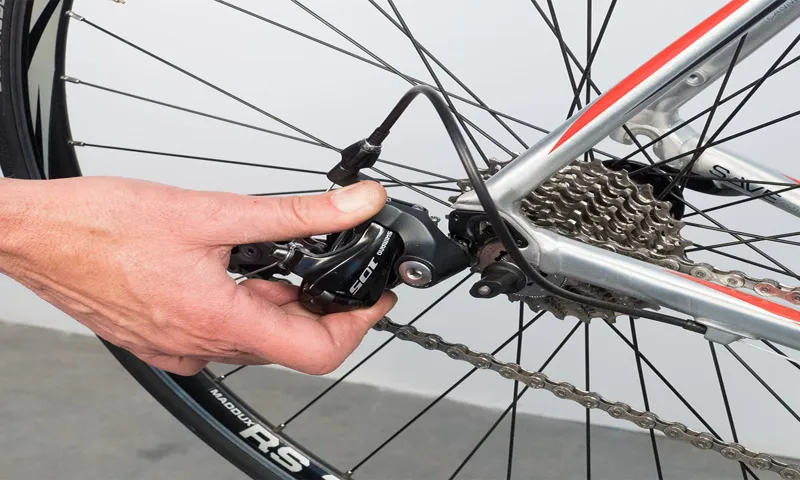As the old saying goes, it’s just like riding a bike – until something goes wrong. Whether it’s a flat tire or a need for repair, taking care of your bike is an essential part of enjoying a smooth ride. One of the most common issues that cyclists face is placing the rear tire back on after it’s been removed for maintenance or replacement.
It can be intimidating at first, but with a little bit of know-how, anyone can do it themselves. So, grab your tools and let’s dive into how to put a rear bike tire back on and get back to cruising down the road.
Table of Contents
Prepare Your Bike and Tools
Putting a rear bike tire back on can be tricky, but with the right tools and preparation, it can be done quickly and easily. Before beginning, ensure that you have all necessary tools handy, including a bike pump, tire levers, and a wrench. Additionally, make sure that your bike frame is clean and dry before beginning any repair work.
When it comes time to put the tire back on, start by placing one of the tire levers between the tire and the rim, then slide it around the circumference of the wheel, lifting the tire away from the rim as you go. Once the tire is removed, inspect the rim and tire for damage, making any necessary repairs before replacing the tire. When putting the tire back on, use your hands to stretch it over the rim, then use a tire lever to work it the rest of the way, being careful not to pinch the inner tube in the process.
Once the tire is securely back in place, pump it up to the recommended pressure level and you’re ready to hit the road!
Remove the Wheel
Removing the wheel from your bike can be a daunting task, but with the right tools and preparation, it can be done easily. First, ensure you have the necessary tools to remove the wheel properly. This can include a wrench, pliers, and a tire lever.
Before starting, it’s important to ensure that your bike is secure and stable. You can use a bike stand or find a solid surface to lean your bike against. Next, loosen the nuts or quick-release lever that hold the wheel in place.
Once loose, remove the wheel slowly and carefully while watching out for the brake pads and chain. It’s important to keep all parts in a safe place to avoid misplacing them. Taking pictures or notes can also be helpful when it comes to reassembling the bike later.
Overall, removing the wheel can seem overwhelming, but by following these simple steps and using the right tools, it can be a breeze.

Inspect the Tire and Rim
Inspecting your bike’s tire and rim is an essential part of preparing for any ride. Before getting started, gather all the necessary tools, including a tire gauge, tire levers, a pump, and a wrench. Begin by inspecting the tire for any cracks, punctures, or tears.
Check the tire pressure, which should be within the recommended range stated on the tire’s sidewall. If it’s low, pump it up and make sure the valve stem is snugly attached. Next, examine the rim for any cracks, dents, or loose spokes.
Tighten any loose spokes and ensure the rim is in good condition. Finally, if the tire needs to be replaced, use tire levers to remove it from the rim. Be cautious when doing this to avoid scratching the rim or puncturing the tube.
With these simple yet crucial preparations, you’ll be ready for your next ride and have peace of mind knowing your bike is in good condition.
Put the Tire Back On
Putting the rear tire back on your bike might seem like a daunting task, but with a few quick steps, you’ll be back on the road in no time. First, make sure your bike is stable and won’t fall over while you work on it. Next, line up the axle with the slot on the frame and carefully slide it into place.
Make sure the chain is properly aligned on the sprocket before inserting the quick release skewer and tightening it snugly. Finally, double-check that the brake calipers are properly aligned and not rubbing on the tire. And there you have it, you’ve successfully put your rear bike tire back on.
Don’t forget to test ride before hitting the road to ensure everything works smoothly. With these simple steps, you won’t be stuck on the side of the road with a flat for long.
Align the Wheel
Align the wheel is an integral part of replacing a tire. Once you have removed the flat tire, it’s important to align the wheel correctly before installing the replacement tire. Failing to correctly align the wheel can cause your car to pull sharply to one side or make steering your vehicle challenging.
To align the wheel, first, check the flat tire for any signs of wear, such as visible damage or low tread. Then, inspect the rim of the wheel for any dents or cracks. Once you’ve made sure the wheel is structurally sound, position it onto the hub and tighten the lug nuts in a star pattern to ensure the wheel sits evenly.
Finally, test the alignment by driving slowly and feeling for any pulling. If everything feels okay, you’ve successfully aligned the wheel.
Secure the Quick Release or Axle
When it comes to putting the tire back on after changing it, the utmost care needs to be taken to secure the quick release or axle. This is the essential step that prevents your wheel from slipping off on the road. To ensure proper positioning, hold the wheel in place and tighten the quick release or axle nut securely.
Make sure the wheel rotates smoothly before securing it further. Don’t forget to check that the brake pads line up correctly with the wheel rim. It’s also important to ensure that the wheel is in the right direction, as indicated by any directional arrows or markings on the tire itself.
Keeping these precautions in mind will help to keep you safe on the road, preventing any potential accidents due to improperly secured wheels.
Pump Up the Tire
After fixing a punctured tire, the next step is to put it back on the car. Start by aligning the rim of the tire with the wheel hub and gently push the tire onto the hub. Make sure that the tire is properly seated by checking the alignment of the valve stem with the rest of the wheel.
Tighten the lug nuts by hand as much as possible, making sure to tighten them in a star pattern to ensure even tightening. Then, use a torque wrench to tighten the lug nuts to the manufacturer’s recommended torque, which can be found in the car manual or online. Once the lug nuts are tightened, double-check that the tire is aligned properly and that the valve stem is not pointing in an odd direction.
Then, remove the jack stands and lower the car back onto the ground. Congratulations, you have successfully put the tire back on! Remember that proper maintenance and regular checkups can prevent tire punctures and ensure a smooth and safe drive. So, pump up those tires and hit the road with confidence!
Test the Tire
Putting a rear bike tire back on can be a bit daunting, but with the right steps, it can be done in no time. The first thing to do is to check the tire before putting it back on. Ensure that there are no cuts or punctures and that the sidewalls are in good condition.
Once you’ve confirmed that the tire is good to go, place the wheel in front of you with the chain resting on the smallest cog on the cassette. Then, take the tire and line up one side of the tire bead with the rim ledge. Work your way around the tire, using your hands or tire levers to coax the other side of the bead onto the rim until the tire is fully flushed with the rim and there are no visible bulges.
Once the tire is mounted, give it a good, firm squeeze all around to ensure that it has seated properly. Finally, test the tire by inflating it to the recommended pressure and spinning the wheel to make sure it’s running true. Congratulations! You have successfully put the rear bike tire back on.
Spin the Wheel
If you’re a car enthusiast, you’ve likely heard of the “Spin the Wheel” game. It’s an exciting way to test the tread and performance of your tires. Essentially, you spin the wheel (or have someone else spin it) and see how long it takes for the tire to come to a complete stop.
This can determine if your tires have enough traction, which is crucial for safe driving. But why is this game useful? Well, tires are the only part of your vehicle that touches the road, making them a critical component of safety. The tread is what allows your car to grip the road, especially in wet or slippery conditions.
The Spin the Wheel game can help you determine if your tires have enough tread, or if it’s time for new tires. It’s important to note that while this game can provide some insight into your tire’s performance, it’s not a definitive measure. Other factors, such as the type of tire and the conditions you drive in, can affect performance as well.
Regular tire maintenance, such as checking air pressure and rotating tires, is important to ensure optimal performance and safety. In conclusion, if you’re looking for a fun way to test the tread on your tires, give “Spin the Wheel” a try. However, don’t rely solely on this game to determine the safety of your tires.
Regular maintenance and inspections by a professional are crucial for optimal performance and safety on the road.
Check the Brakes
When it comes to ensuring the safety of your vehicle, testing the tires is crucial. Before hitting the road, take a few moments to inspect the tires for any signs of wear and tear. Check the tire pressure and make sure it is at the recommended level.
Additionally, inspect the tread depth and ensure that it meets the legal requirements for safe driving. If the tread is too worn, it’s time to replace the tires. Remember that driving on bald tires can be extremely dangerous, especially in wet or slippery conditions.
Don’t put yourself and others at risk – always test your tires before embarking on a journey.
Conclusion
Putting a rear bike tire back on may seem like a daunting task, but with a few simple steps it can be done in no time. Just remember, it’s all about getting the chain into the right place and tightening everything up. So don’t be afraid to get down and dirty with your bike, give it the TLC it needs and it’ll be good to go.
And if all else fails, just remember the wise words of Mark Twain, “Get a bicycle. You will not regret it. If you live.
” Happy riding!”
FAQs
How do I remove the rear bike tire?
To remove the rear tire of a bicycle, start by shifting the chain to the smallest cog on the rear wheel. Then, use a wrench to loosen the nuts or quick release lever that hold the wheel in place. Once loosened, lift the bike frame off the wheel and slide the wheel out of the frame.
How do I put the rear bike tire back on?
To put the rear tire of a bicycle back on, align the wheel with the frame and use a wrench or quick release lever to tighten the nuts or lever on the axle that holds it in place. Make sure the wheel is centered and the chain is properly aligned before tightening the nuts or lever completely.
How tight should the rear wheel nuts be?
The rear wheel nuts on a bicycle should be tightened enough to hold the wheel securely in place, but not so tight that they damage the frame or axle. Use a torque wrench if possible to ensure the nuts are tightened to the manufacturer’s recommended specifications.
What do I do if the rear wheel won’t fit back in the frame?
If the rear wheel won’t fit back in the frame, check to make sure the derailleur or brake mechanism is not in the way. If it is, adjust it so that it clears the wheel. If the wheel still won’t fit, check to see if the axle is bent or the frame is damaged.
How do I know if the rear wheel needs truing?
To determine if the rear wheel of a bicycle needs truing, spin it and look for any wobbling or side-to-side movement. Use a spoke wrench to adjust any spokes that are too loose or too tight, which can help straighten the wheel and eliminate wobbling.
Can I replace the rear bike tire myself?
Yes, you can replace the rear tire of a bicycle yourself if you have the right tools and knowledge. Start by removing the old tire and tube, then install the new tube and tire. Make sure to inflate the tire to the proper pressure and check it for any leaks or damage before riding.
How often should I replace the rear bike tire?
The frequency with which you need to replace the rear tire on a bicycle depends on how frequently you ride and the condition of the tire. Check the tire regularly for signs of wear or damage, and replace it if the tread is worn down, there are cuts or punctures, or the sidewalls are cracked or damaged.



